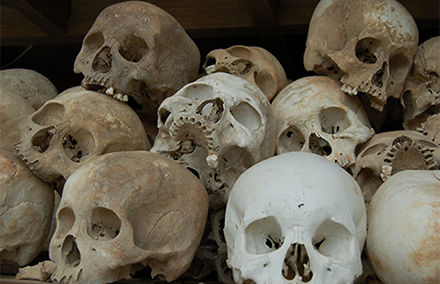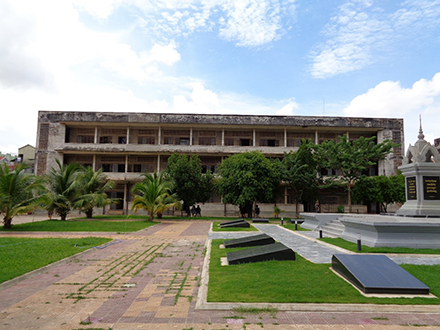
Photo by Chin,Singapore on flickr
Could state destruction and absence have helped trigger genocide?
As part of its Ideas series, the London School of Economics (LSE) held a thought-provoking lecture on the origins of the Final Solution. The speaker, Professor Timothy Snyder, argued that the mass murder of Jews was carried out most thoroughly in areas where state structures had been systematically destroyed. (Watch the full lecture here.)
Germany’s colonial war in Eastern Europe, coupled with the Soviet Union’s capacity for state destruction, helped create vast swathes of territory that were essentially “zones of lawlessness”. Snyder went on to explain how statelessness, the absence of the state, and process of state destruction created opportunities for extreme violence that the SS, Ordnungspolizei (Order Police) and Nazi collaborators capitalised on.
Can other instances of mass violence be reconciled with the arguments set out by Professor Snyder during his lecture and book Black Earth: The Holocaust as History and Warning? More specifically, can we apply these ideas to the levels of extreme violence reached under the Khmer Rouge? And, if so, can we add another explanation to the pre-existing wealth of literature on mass killings and genocide in Cambodia?
Scholars have long debated the origins, causes and courses of genocide. Cambodia has been no exception. Some have opted for culturally-driven explanations. Some of those who support the trials of Khmer Rouge leaders at the Extraordinary Chambers in the Courts of Cambodia may subscribe to the centrally-directed, or top-down version of how events unfolded in the Southeast Asian nation.
Still others, such as Stephen Heder, look at the decentralisation of violence in Cambodia. This includes the prevalence of local initiatives and localised killings outside of Central Committee directives, flexible interpretations of central directives, and multiple layers of responsibility.
Perhaps, though, the absence of a functioning state and the prevalence of lawlessness are additional factors to consider seriously.
On coming to power, the Khmer Rouge set about destroying what remained of the corrupt Lon Nol government and state. Ministries, transportation, healthcare and education ceased to function. Furthermore, by emptying the bureaucratic centre of Phnom Penh, the Khmer Rouge made clear their intentions to remove any vestiges of the ancien régime and launch one of the most radical social experiments in history.
It is important to recognise how and why such a policy was deemed necessary. Therefore, we must understand the worldview of the Communist Party’s Central Committee, most notably leader Pol Pot and chief ideologist Nuon Chea.
Influenced by a combination of Marxism-Leninism and Maoism, and inspired by the Great Leap Forward and the Cultural Revolution in China, the Cambodian Communist Party leadership believed that they could achieve “independence mastery” by first focusing on rice cultivation and export before moving towards light and finally heavy industry. The ‘idyllification’ of rural and agricultural production was further reinforced by the ancient example set by the empire centred upon Angkor.
Another key aspect was the institutionalised secrecy and paranoia that characterised the leadership, a product of years of targeted suppression by Prince Sihanouk and the authorities.
Additionally, the Khmer Rouge were a steadfastly revolutionary organisation, more comfortable making war than making a state. The regime’s directives and proverbs were infused with military language. The construction of canals and trenches for agriculture, for instance, were often compared with being on the front-line.

S-21 (Tuol Sleng Genocide Museum). A state-directed institution of torture and murder. But did lawlessness and the absence of a functioning state contribute to the mass killings in Cambodia? Photo by the author.
Building a conventional state does not seem to have been a serious consideration. Many high-ranking Khmer Rouge lacked any bureaucratic expertise. On the contrary, those with such expertise were arrested, imprisoned and murdered for having affiliations with the previous government. The regime never approached anywhere near the levels of bureaucracy associated with a modern functioning state; revolutionary will alone was deemed enough.
What “state-directed” planning there was was ill-thought out and unrealistic. The Khmer Rouge’s “Four Year Plan” epitomised this. Derived from minimal research, and in complete ignorance of ecological variance, the Plan aimed to collectivise agriculture and industries and spend the earnings from agricultural exports on light and eventually heavy industry. It also called for the production of three tons of rice per hectare, despite the fact that, as David Chandler has written, that pre-1970 yields averaged less than one ton of unhusked rice per hectare.
This did not deter the regime. In fact, reaching these unrealistic goals were intended to illustrate the superiority of “revolutionary will” to careful planning and the ‘transferability of military zeal into the economic sphere’ (see pp 113-136 of Chandler’s Brother Number One: A Political Biography of Pol Pot). The raw capacity was already there, only the revolutionary will had to be tapped into.
The destruction of the state, and of law, created opportunities for extreme violence, both at S-21 (Tuol Sleng), the quintessential torture institution of the centre, and at the peripheries. The “law” that did prevail was one that painted extreme violence as a legitimate form of governance.
The absence of a functioning state, legal structures and checks and balances, meant that the only rule in this essentially lawless environment was the rule of revolutionary will and loyalty to the faceless Angka. This extended to killings. If you spoke against or questioned the Angka, stole from the Angka, or were unlucky enough to fall under one of the vaguely defined and locally interpreted categories of “enemies of the state”, then you risked being “scattered” (komchat).
As the purges escalated in the latter years of the 1970s, the regime essentially cannibalised. The absence of ameliorative mechanisms or structures to fall back on meant that the revolution overwhelmed itself, becoming more paranoid and violent with each passing day.
While only a tentative account requiring much more intensive study, perhaps herein lies another explanation for the extreme levels of violence seen during the regime’s short but brutal reign. And, as the author of Black Earth states in the subtitle to his work, a “warning” to the consequences of what can happen in a stateless, lawless environment.
Scott Rawlinson received his MA in South East Asian Studies from the School of Oriental and African Studies (SOAS), University of London. He is currently a Fellow, and Coordinator for Fellows, at the Cambodian Institute for Strategic Studies (CISS), Phnom Penh, and will commence his PhD at SOAS in September 2016. All opinions are those of the author and do not necessarily reflect the views of the Institute.
 Facebook
Facebook  Twitter
Twitter  Soundcloud
Soundcloud  Youtube
Youtube  Rss
Rss